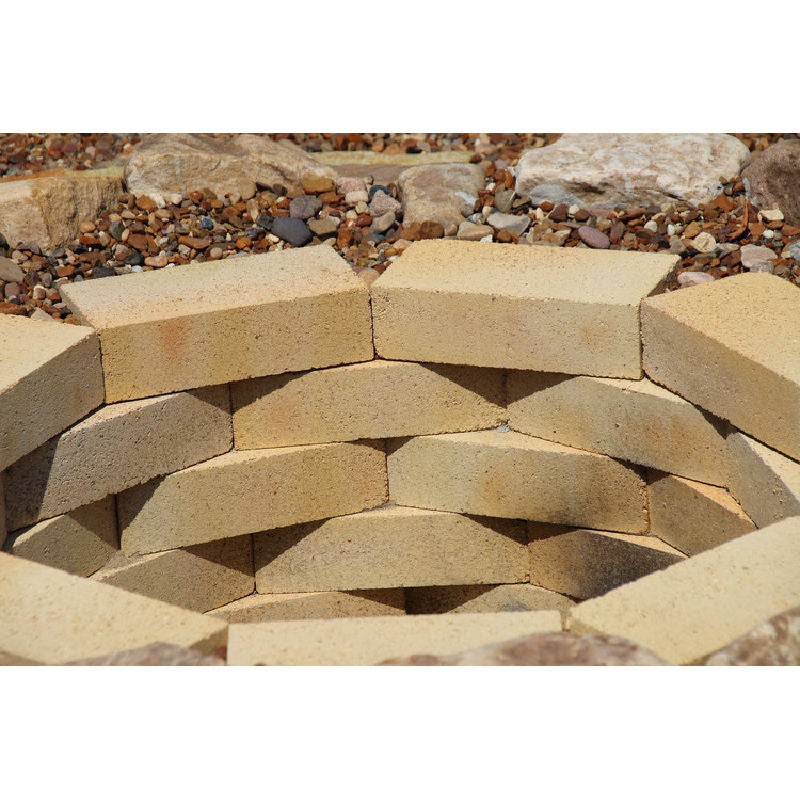
Fire Pit Bricks | Refractory: FAQ
Table of Contents
Fire bricks, also known as refractory bricks, are a unique type of brick made from fire clay and are highly resistant to extreme temperatures. They are commonly utilized in kilns, furnace linings, fireplaces, and fireboxes. Fire bricks are manufactured similarly to standard bricks, but they undergo a burning process during which they are subjected to exceptionally high temperatures.
What are fire bricks?

Fire bricks, or refractory bricks, are a unique type of brick made from fire clay and are highly resistant to extreme temperatures. They are commonly used in kilns, furnace linings, fireplaces, and fireboxes.
What is fire clay?
Fire clay is a special type of clay used to make fire bricks. It contains two primary components, silica and alumina, and may include other constituents such as calcium, magnesium, iron, potassium, and titanium oxides. You often see sculpted fire clay used for permanent outdoor pizza ovens and cooking fixtures.

How are fire bricks classified?
Fire bricks are classified into three major types based on their fire-resisting capabilities:
- High-grade fire clays
- Medium-grade fire clays
- Low-grade fire clays
What temperature are fire bricks rated to?
|
Grade of Fire Clay |
Temperature Resistance Range (°C) |
|
High |
1482 – 1648 |
|
Medium |
1315 – 1482 |
|
Low |
Up to 870 |
What are the different types of fire bricks?
There are three main types of fire bricks:
- Acidic fire bricks
- Basic (alkaline) fire bricks
- Neutral fire bricks
How are acidic fire bricks made?
Acidic fire bricks, or acid-resistant bricks, are made by adding additional silica to fire clay, making up to 97% of its composition. Lime (1-2%) is used as a binding agent, and the bricks are fired at high temperatures for extended periods.
What are basic (alkaline) fire bricks used for?
Basic fire bricks provide excellent corrosion and chemical resistance. They contain a high amount of magnesia and lime as a binding material. Some examples of basic fire bricks include magnesite bricks, magnesia-carbon, and magnesia-chrome bricks.
What are neutral fire bricks?
Neutral fire bricks are suitable for both acidic and basic lining purposes, offering resistance to acidic fumes and corrosive actions. They come in two types: high alumina bricks and chromite bricks.
What are the properties of fire bricks?
Fire bricks have several properties, including:
- Yellowish-white, orange-red, or white color
- Available in various sizes: typical ones are in the range of - 20 x 12 x 6 cm to 20 x 7 x 5.5 cm.
- Typical weight of 1-5 kg.
- Compressive strength of 200 to 220 Kg/cm²
- Water absorption percentage of 5 to 10%
- Good chemical resistance
What are the main uses of fire bricks?
Fire bricks are used for the following purposes:
- DIY fire pits
- lining the inside of Grills, smokers, and BBQ's
- Lining the inner surfaces of kilns, furnaces, and chimneys
- Constructing fire-resistant structures
- Lining the interiors of wood-fired ovens
- Insulating furnaces and ovens due to their low thermal conductivity
How do I choose the right type of fire brick for my project?
Choosing the right type of fire brick depends on the specific application and the temperature resistance required.
- Acidic fire bricks, also known as acid-resistant bricks, are specifically designed to withstand acidic conditions caused by chemicals or weather.
- Basic fire bricks provide excellent corrosion and chemical resistance.
- Neutral fire bricks are suitable for both acidic and basic lining purposes, offering resistance to acidic fumes and corrosive actions.
Consult a professional or refer to the manufacturer's recommendations for guidance on selecting the appropriate fire brick for your project.
Now you know everything about fire bricks, it's time to find out everything there is to know about Fire Pits! Check out our Ultimate Fire Pit Guide!



Leave a comment